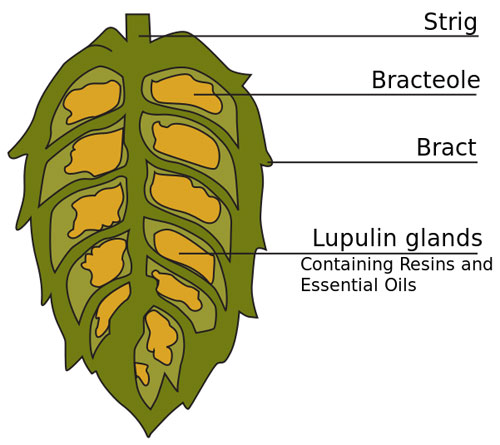Harvest time approaching for hop growers
Determining the correct harvest date is a mix of art and science and has a big impact on the quality of the final product.
Hop harvest in Michigan occurs primarily from late August through September with actual dates depending on cultivar, exact location and conditions during the growing season. When attempting to determine harvest timing, Michigan State University Extension recommends growers should consider cone maturity and moisture content, weather conditions, pest pressures and market influences.
The three primary components of brewing value of the hop are the alpha-acids (bittering agent), beta-acids (preservative) and essential oils (aroma). Recent work at Oregon State University (OSU) by Tom Shellhammer continues to shed light on the importance of harvest date and the potential effects on these brewing qualities. Of particular importance to Michigan’s aromatic hops producers is the data generated regarding essential oil content, thought to be the primary source of aroma. Essential oil content is found to increase well past the typical commercial harvest dates, perhaps lending credence to concerns that we may be harvesting our hops before the optimal timing. Not surprisingly, hops harvested at different dates produced beer with significant, distinguishable differences in sensory analysis testing indicating the importance of harvest date on beer quality.
Given the findings at OSU, a late harvest timing appears ideal at first, however harvesting hops cones late can actually reduce aroma and shorten the storage life of the hops if stored in bales. When harvested too late, accelerated oxidation and loss of volatile aroma compounds can occur in storage; these problems can be exacerbated by pest damage to the cones. This knowledge must be balanced with the previously mentioned findings that essential oil content increases in hop cones harvested later. Conversely, harvesting cones too early reduces yield and flavor and can reduce vigor and yield in subsequent seasons due to a disruption in the natural reallocation of carbohydrates to the root system late in the season.
In the major hop growing regions, harvest is generally targeted when cones reach an average of 23 percent dry matter. The Oregon Hop Commission provides some limited varietal recommendations for specific dry matter targets. Growers can expect dry matter content to increase by 1 percent every four to seven days, depending on variety and environment.
The University of Vermont Extension provided the following protocol to determine the percentage of dry matter. Begin by randomly sampling five to 10 sidearms of the same variety from throughout the hopyard. Samples should be taken from near the top of the trellis, approximately 2 feet below the trellis wire. The sample should reflect the state of your yard and should be taken when there isn’t excess moisture in the hopyard, i.e., after the morning dew has dried, when it isn’t raining, etc. Pick the cones off of the sidearm into a bucket and mix thoroughly before selecting a subsample of 100 to 150 cones. Once you have your subsample, you can begin the determination of dry matter.
Weigh an empty container in grams. Weigh the freshly picked hops in the container and record both weights. Dry the hops down to 0 percent moisture. This can be done one of several ways:
- Overnight in a food dehydrator at 140 to 150 degrees Fahrenheit.
- In a Koster Moisture Tester (commonly used to test forage moisture).
- In a microwave oven or conventional oven, being sure to remove the sample every minute or less to prevent scorching. Samples dried in a microwave oven must be watched very closely (every 30 to 45 seconds) and dried at around 50 percent power to prevent heat buildup in the microwave oven that can damage it.
Using a food dehydrator will allow the cones to dry to 0 percent moisture overnight. However, the Koster tester and microwave methods require constant monitoring as they will dry the cones relatively quickly. Once the sample has reached a stable weight, the hops are at 0 percent moisture. Weigh the dry hops and record the weight in grams.
To calculate the percent dry matter, use the following equation:
Some additional wisdom from the field suggests that cones approaching maturity become light green to yellowish and take on a dry, papery feel. The lupulin gland will turn from a pale yellow to a dark yellow-orange hue. When crushed in the hand, mature cones may crumble and do not rebound. Cones should not be completely brown at harvest.



 Print
Print Email
Email



